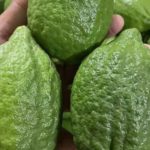Have you ever heard of the leaves of the chúc tree? This is a plant related to citrus species, very popular in Asia. The chúc tree has a lot of health benefits as well as many culinary uses. Join us to discover interesting information about the chúc tree through the following article.
1 What is the chúc tree?
The chúc tree, also known as Thai lemon, Makrut lime, kaffir lime, or Magrood lime, is native to Asian countries such as Laos, Indonesia, Malaysia, Thailand, and Vietnam. Nowadays, it is widely cultivated around the world for its use as a spice, flavoring agent, and cosmetic ingredient.
 The chúc tree originates from Asia
The chúc tree originates from Asia
2 Characteristics of the chúc tree
The chúc tree belongs to the Rutaceae family and is a woody tree that can grow up to 2-10 meters tall with lateral spines on its trunk.
Its leaves are lanceolate or oblong, with toothed or entire margins, and a rounded, sometimes notched or pointed apex. They are dark green and have very broad wings on the petioles, sometimes as wide as the leaf blade, giving them a distinctive figure-8 shape. The leaves have a pungent, tangy fragrance and a sour taste, reminiscent of a combination of lemon, young grapefruit, and fresh curry leaves.
 The chúc tree belongs to the Rutaceae family
The chúc tree belongs to the Rutaceae family
The fruits of the chúc tree are larger than lemons, with a rough skin, high water content, and a tangy, sour taste. They have a stronger and more lasting aroma than rough lemons.
The chúc tree is easy to grow, hardy, drought-tolerant, and bears fruit once a year during the rainy season.
3 Benefits of the chúc tree
The chúc tree has numerous health benefits, including:
Improving oral health
The essential oil from chúc leaves has antibacterial properties and helps eliminate harmful bacteria in the oral cavity. Rubbing chúc leaves directly on the gums can keep your mouth fresh and bacteria-free.
 Improve oral health with chúc leaves
Improve oral health with chúc leaves
Relieving dry cough
Chúc leaves contain more essential oils than oranges and lemons, making them very effective in treating coughs. Chop fresh chúc leaves finely, add a few slices of ginger and honey, and steam for about 10 minutes. Consume this mixture daily by mixing it with warm water.
 Steaming chúc leaves with ginger and honey
Steaming chúc leaves with ginger and honey
Treating headaches, relieving flu symptoms, and inducing sweating
Since the chúc tree is related to oranges and lemons, it has similar benefits, including relieving flu symptoms and fatigue. Boil a pot of water with chúc leaves, grapefruit leaves, a few slices of lemon, ginger, and lemongrass, and use it for steam inhalation. This will help keep flu and headaches at bay.
 Steam inhalation with chúc leaves to treat flu and headaches
Steam inhalation with chúc leaves to treat flu and headaches
Treating dandruff and promoting smooth hair
Boiling chúc leaves and using the water to wash your hair can help treat dandruff, itching, hair loss, and make your hair smoother and softer. This natural hair care method is trusted by the Khmer people.
 Treating dandruff and promoting smooth hair with chúc leaves
Treating dandruff and promoting smooth hair with chúc leaves
Removing fishy odors and purifying the air
You can use the juice and leaves of the chúc fruit instead of lemon to remove the fishy odor from meat and seafood. Additionally, you can hang pouches of chúc essential oil or crushed leaves in your room to let the fragrance spread and create a pleasant and relaxing atmosphere.
 Chúc tree essential oil
Chúc tree essential oil
Repelling insects and reptiles
You can plant chúc trees in front of your house to drive away snakes, scorpions, mosquitoes, and other insects. Alternatively, you can boil a pot of chúc leaves, place it in a corner of the room, and use the steam to repel insects and reptiles.
 Chúc tree repels reptiles
Chúc tree repels reptiles
4 Delicious dishes made with the chúc tree
The entire chúc tree, from its leaves to its fruits, is rich in aromatic essential oils, making it a versatile ingredient in cooking. The most commonly used parts are the leaves and fruits (including the juice and peel).
Chúc leaves
Chúc leaves have a tangy flavor similar to lemon leaves but with a more intense and pungent aroma. They are not bitter and retain their fragrance even after prolonged cooking at high temperatures. Young chúc leaves are used in curries and soups by cutting them finely or into strips or by making a sauce to marinate meat or seafood.
 Chicken steamed with chúc leaves
Chicken steamed with chúc leaves
You can also sprinkle shredded chúc leaves on dishes like noodles, grilled meat, fried rice, spring rolls, pancakes, and salads to enhance their flavor.
Chúc fruits
The fruits of the chúc tree can be used just like lemons. The juice can be used to remove odors, in salads, as a dipping sauce, or in drinks. It has a strong, tangy taste and a rich, intense aroma.
 Using chúc fruit juice as a dipping sauce
Using chúc fruit juice as a dipping sauce
Chúc fruit peels
The peels of chúc fruits are used as a flavoring agent to remove odors from water and to add a refreshing taste to drinks. The peels have a distinctive bitter, spicy, and mildly fragrant flavor, making them ideal for enhancing the freshness of drinks like soda.
 Making drinks with chúc fruit peels
Making drinks with chúc fruit peels
Now you know more about the chúc tree, its characteristics, and its various benefits. We hope this article has provided you with useful information. Follow us to stay tuned for more interesting articles.































